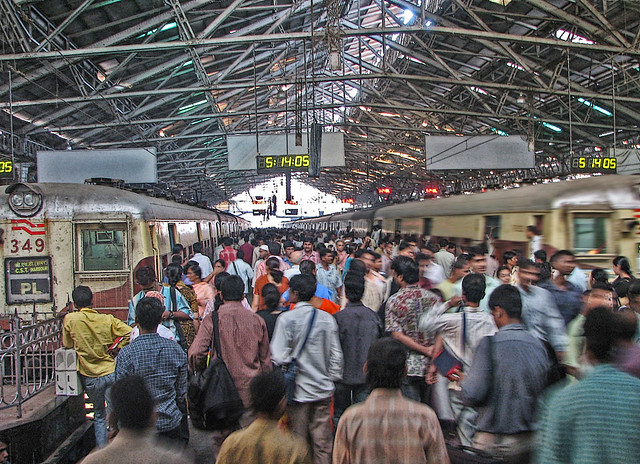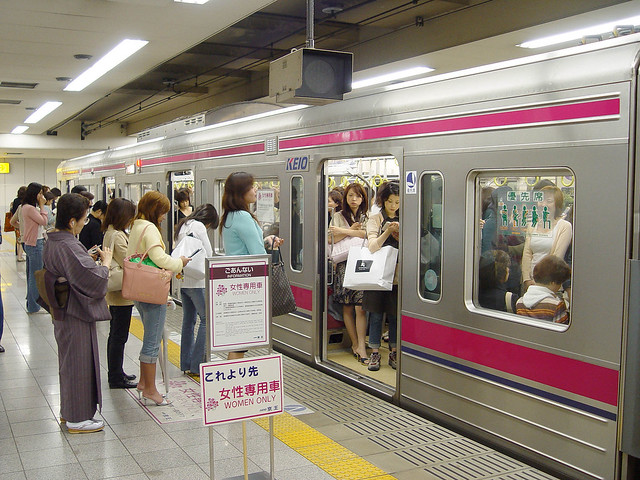[The Chicago Reader recently launched a new weekly transportation column written by Streetsblog Chicago editor John Greenfield. This partnership allows Streetsblog to extend the reach of our livable streets advocacy. We syndicate a portion of the column on the day it comes out online; you can read the remainder on the Reader’s website or in print. The paper hits the streets on Thursdays.]
Last month in the wake of hundreds of reported sexual assaults on New Year's Eve in Cologne, a German commuter train line announced it would offer railcars reserved for women and children. Crowded transit systems in Japan, Indonesia, India, Egypt, Mexico, and Brazil already feature women-only rail cars in order to prevent harassment and assaults.
In response to that news, last week NPR commentator Rhitu Chatterjee wrote glowingly of the ladies' cars in her hometown of Delhi.
"It would be wonderful if men learned to accept women's presence in public spaces without feeling the need to harass them," Chatterjee wrote. "But until they do, the women's car is one good way for us to assert our right to public spaces."
Her op-ed got me thinking about whether female-only cars might be a strategy to combat sexual intimidation and violence on the CTA.
In 2015 there were eight reported sexual assaults on the CTA—a category that includes everything from groping to rape—according to spokesman Jeff Tolman. He characterized that as "extremely few instances," considering that 516 million rides were taken last year.
While lesser offenses often aren't reported to the CTA or police, stories female friends and colleagues shared with me by for this article suggest that inappropriate behavior is all too common on the system.

Jane, a 43-year-old urban planner (who like many women I spoke to asked that we not use her real name), reported that men have catcalled and exposed themselves to her on the el on multiple occasions. Alice, a 53-year-old legal assistant, told me she's tall and assertive enough to intimidate would-be offenders, but has petite friends who've endured so much harassment that they only ride the train alone at rush hour, or not at all.
One of them is Blanca Robledo-Atwood, a Colombian-born graphic designer who's four-feet-11. One evening she was riding the Red Line when a tall, beefy guy sat down next to her and whispered in her ear, "You are so beautiful—I want to be your friend."
After trying in vain to ignore his advances, she spoke loudly to him in Spanish, which he didn't seem to understand. "He got embarrassed and tried to hide," she recalls. Still, she feared the man would follow her off the train. After that she stopped riding the el by herself at night.
The man who tried to hit on 34-year-old nonprofit worker Ellen on the Blue Line's Jackson platform at 2 AM was less polite. After she made it clear she wasn't interested, he snarled, "Well I'm a nice guy, but I hope your boyfriend continues to beat and rape you."
Ellen held her ground in the ensuing shouting match, but she now thinks that was unwise. "I could have gotten stabbed that night-who knows," she says. After that she largely switched to commuting by bicycle. "I get high anxiety sometimes when I enter CTA trains, no matter how much I think I'm a strong and badass woman, and it pisses me off to feel that way."
Brittany, 28, survived a sexual assault that occurred while she was riding the Blue Line out to Oak Park on a Tuesday afternoon in May 2014. As the train crawled through a slow zone west of the Kedzie-Homan station, a large man approached her in the otherwise empty car.
The assailant held her down and attempted to rape her. She was able to snap his photo as he fled. (A few months later police apprehended the man, who'd been attacking other women for years, she says. He's now doing jail time.)
Brittany rides the el less often nowadays, and when she does she tries to sit in the front car, with the driver. "I still have major issues taking trains," she says.




